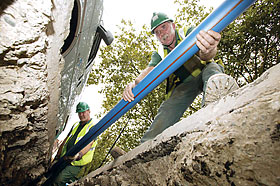 |
| In with the New. Thames Water is spending $180 million a year to replace aging water pipes. |
Like runners in a relay, water and wastewater utilities across England and Wales are hot off the starting block on a $30-billion, five-year construction sprint. This is the fourth round of environmental infrastructure upgrades since utilities were privatized in 1989, but it will now be a showcase for new procurement and management strategies to reduce burdens on capital budgets—and on ratepayers.
Utilities must cope with new regulatory imperatives, aging facilities and changes in capacity demand. The current five-year program, known as Asset Management Plan 4 (AMP4), has a big mission through 2010. It specifies 1,000 projects to upgrade effluent quality at wastewater treatment plants, 2,000 to cope with intermittent waste spills and nearly 230 to upgrade water treatment and pumping. The program’s total pricetag will add about $1,300 in costs per household, according to the U.K. regulating agency, the Office of Water Services (OFWAT).
“There are many, many projects to do. That brings with it a different type of challenge,” says Ian McAulay, managing director of MWH U.K. Ltd., the Warrington, England-based unit of MWH, the Broomfield, Colo., giant. Utilities will again rely on integrated teams, working with their design and construction providers to handle workload, says Nick Harney, director for water-wastewater projects at WS Atkins, Epsom, England.
Private Entities
Britain’s unusual infrastructure investment stems directly from when the 10 large water and wastewater entities in England and Wales were sold on the stock market. But lacking real competition, utilities are still heavily regulated by OFWAT. In Scotland and Northern Ireland, water-wastewater sectors are much smaller, still publicly owned and regulated differently.
 |
| Big Fix. Five-year program includes construction projects at 1,000 wastewater treatment plants. |
Since 1989, large English and Welsh utilities and OFWAT have engaged in intense negotiation every five years over infrastructure investment needed because costs are financed from customer bills. OFWAT sets corresponding price hike limits for each utility. The review for AMP4 began in 2002 but only concluded early last year. The agency agreed to approve about $30 billion of investment, about $7 billion less than the utility firms sought.
OFWAT’s investment figures assume ever-increasing efficiency in utility construction. If companies can improve on OFWAT’s cost assumptions, they keep the savings. “But we will account for that [improved] efficiency in the next pricing period,” says Kevin Ridout, an OFWAT principal engineer.
| Capital expenditure* by utility, 2005-2009 | ||
| Company | Total Spending (In $ Bil.) | AV. Investment/ Customer (In Actual $) |
| Anglian | $2.6 | $233 |
| Dwr Cymru (Welsh Water) | 2.0 | 313 |
| Northumbrian | 1.5 | 133 |
| Severn Trent | 3.9 | 221 |
| South West. | 1.4 | 382 |
| Southern | 2.8 | 345 |
| Thames | 5.5 | 266 |
| United Utilities | 4.4 | 301 |
| Wessex | 1.3 | 336 |
| Yorkshire | 2.5 | 250 |
| Industry total | $29.8 | $650 |
| * Investment financed through customers bills. Source: OFWAT. Rate of exchange used £1=$1.77 | ||
With each successive five-year spending program, OFWAT extracts ever more efficiency from utility construction by squeezing allowable rate hikes. “That forces our clients to think outside the box and look at other methods,” says Ian Kirkaldy, regional director of client services at Black & Veatch Ltd., the Redhill-based unit of the U.S. firm based in Kansas City. When the first AMP began in 1990, utilities “all effectively started at the same place,” he says. “The challenge...was all about delivery after years of underinvestment...with a small resource base to do it.”
As time passed, however, utilities' ownership and goals both diverged. Some firms are still listed on the U.K. stock exchange, while a few have been acquired by corporations. As a result, approaches to project management in various AMP periods have changed. While working more collaboratively with the construction industry, has produced efficiencies, two utilities with big building missions are bucking that trend. The firms are wresting more program management control from construction providers than ever before, in the cost-saving drive.
Changing Priorities
Thames Water Utilities Ltd., which serves the London area, is one. Its $5.4-billion AMP4 program includes spending about $200 million each to upgrade several large treatment plants, and $180 million a year to replace pipes in its...
